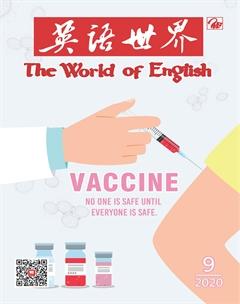疫苗简史
邓梦寒
It is hard to fully appreciate how vaccines have revolutionized modern medicine. The long schedule of vaccines may seem like a hassle, and rumors about harmful effects unnerve parents. But, the fact is, vaccines have helped save millions and millions of lives. Just a few generations ago, people lived under the constant threat of deadly infectious diseases, like smallpox, polio, and hepatitis. Lets look at the greatest infectious scourges of the past 1,000 years and how vaccines have mitigated or even eradicated the danger.
Prior to the 15th Century: Infectious disease has always impacted humanity, but even as early as 1,000 years ago, there is evidence people recognized the connection between exposure and immunity. The ancient Chinese may have used pulverized smallpox scabs taken from the sick and inhaled or rubbed them onto skin to immunize themselves. This primitive form of inoculation was practiced in Africa and the Middle East too before spreading to Europe.
16th Century: Smallpox, measles, and whooping cough were terribly common in the 1500s, with outbreaks recorded around the world. Contagious diseases like these spread quickly, especially in crowded, dirty cities. Children were especially vulnerable. Records from 16th century England indicate that as many as 30% of all children died before the age of 15, likely from dysentery, scarlet fever, whooping cough, influenza, smallpox, and pneumonia.
17th Century: When Christopher Columbus discovered the Americas in 1492, he and the Europeans that followed him unwittingly brought with them smallpox, measles, whooping cough, chicken pox, bubonic plague, typhus, and malaria. The native people, with no history of these diseases and no natural resistance, died by the millions over the 150 years that followed initial contact with European explorers. An estimated 80% to 95% of the population perished. There is perhaps no more terrible an example from history to illustrate the importance of antibodies in resisting infectious disease.
18th Century: The 1700s were a watershed century for vaccine develop-ment. Europeans realized that survivors of certain infectious diseases were immune to future exposure, and began a primitive form of inoculation by intentionally infecting themselves with a disease to gain immunity.
The risk of sickness and death with this early approach was high, but it shed light on the basic principles behind immunology and enabled British doctor Edward Jenner to develop the worlds first true vaccine. In 1796, Jenner discovered that if he infected people with the related, though relatively benign, cowpox virus he could inoculate patients with far lower mortality rates.
19th Century: After Dr. Jenners discovery of “cow pox” as the first relatively safe vaccination against smallpox, knowledge of the procedure spread rapidly and became common throughout the world. Vaccine development finally made another major step forward 85 years later when Louis Pasteur identified bacteria as a major culprit behind several diseases and used this knowledge to produce the first “lab-made” vaccination.
20th Century: At the start of the 20th century, infectious diseases like yellow fever and polio still ravaged populations in Europe and the United States. But as the century progressed, scientists built upon the immunological fundamentals discovered over the past century and developed individual vaccinations for 27 major infectious diseases. By the year 2000, centuries-old scourges like smallpox and measles were virtually eliminated from the developed world, along with yellow fever, polio and several others.
21st Century: Since 1995, five new vaccines were added to the childrens immunization schedule in the U.S., which the CDC estimated saved thousands of lives. The pneumococcal conjugate vaccine, added in 2001, likely saved 13,000 U.S. lives from 2001 to 2008. And the rotavirus vaccination, added in 2006, is now estimated to prevent 40,000—60,000 hospitalizations yearly.
On the global scale, health organizations continue to distribute vaccines to poorer countries. Thanks to increased access to the measles vaccine internationally, the annual death toll from the disease has fallen from almost 600,000 in 2000 to just 122,000 in 2012, a reduction of 79%.
Future of Vaccines: While existing vaccines continue to be improved and distributed, the scientific community continues to work on a few difficult diseases. There is no working vaccine for HIV, malaria, or tuberculosis (there is a TB vaccine for children, but not adults). Consequently, these diseases continue to kill millions around the world.
A new generation of cancer vaccines, designed to train the body to better fight cancer, is also in early stages of development. The scientific community believes these drugs hold great promise for addressing growing rates of cancer, now the second most common cause of death in the United States.
很難充分体会疫苗如何变革了现代医学。长长的疫苗接种时间表可能看似挺麻烦,关于疫苗危害作用的谣言也使家长紧张不已。但事实上,疫苗已经挽救了无数生命。就在几代人之前,人们还一直受到天花、小儿麻痹症和肝炎等致命传染性疾病的威胁。让我们看看过去1000年最严重的疫病灾难,看看疫苗是如何减轻甚或消除这类危害的。
15世纪以前:传染性疾病一直危害人类,但早在1000年前就有证据表明,人们早就意识到了接触与免疫之间的关系。古代中国人可能早已将天花病人的痂研磨成粉并将其吸入或擦在自己皮肤上来获得免疫。这种原始的接种方式在传到欧洲之前,也盛行于非洲和中东。
16世纪:天花、麻疹和百日咳在16世纪极为常见,世界各地都有暴发记录。这类传染性疾病传播极快,尤其是在拥挤、肮脏的城市。儿童尤为易感。16世纪英格兰的记录显示,多达30%的儿童在15岁前夭折,他们很可能是死于痢疾、猩红热、百日咳、流感、天花和肺炎。
17世纪:克里斯托弗·哥伦布1492年发现美洲,与此同时,他和随后前往美洲的欧洲人不经意间也带去了天花、麻疹、百日咳、水痘、黑死病、斑疹伤寒和疟疾。美洲原住民由于没有得过这些疾病也没有先天抵抗力,在最初接触这些欧洲探险者后的150年中,有数百万人死去。据估计,80%到95%的原住民人口消失了。历史上或许没有比这更可怕的例子证明抗体在对抗传染病过程中的重要性了。
18世纪:18世纪是疫苗发展的转折点。欧洲人发现,某些传染病的幸存者在未来接触这种疾病时具有了免疫力,于是他们开始进行一种原始的接種,通过刻意使自身感染疾病来获得免疫。
这种早期尝试的致病和致死风险很高,却揭示了免疫学的基本原理并使英国医生爱德华·詹纳得以研制出世界上第一支真正的疫苗。1796年,詹纳发现,当他使人们感染与天花病毒相近但相对无害的牛痘病毒后,接种病人死亡率大幅降低。
19世纪:詹纳医生发现的“牛痘”成为对抗天花的第一种相对安全的疫苗。施种步骤随后迅速传播,成为全世界普遍的接种方式。 85年后,疫苗发展终于又跨越了重要一步,路易·巴斯德发现了细菌是导致多种疾病的罪魁祸首,他运用这一知识研制了第一支“实验室制造”的疫苗。
20世纪:20世纪初,欧洲和美国仍然有大量人口受到黄热病和小儿麻痹症等传染病的侵害。不过,随着时间推移,科学家基于19世纪发现的免疫学原理,研制出分别针对27种主要传染病的疫苗。截至2000年,像天花和麻疹这样古老的疫病以及黄热病、小儿麻痹症和几种其他传染病在发达国家几乎销声匿迹。
21世纪:1995年以来,美国儿童的疫苗计划中又增加了5种新疫苗——根据美国疾病控制与预防中心的估算,这些新疫苗挽救了成千上万的生命。2001年新增的肺炎双球菌疫苗很可能在2001年至2008年间挽救了1.3万美国人。2006年新增的轮状病毒疫苗目前估计每年可使4万到6万人免于住院治疗。
在全球范围内,卫生组织持续为贫困国家分发疫苗。由于全世界越来越多的地方可以接种麻疹疫苗,每年死于该病的人数从2000年近60万降至2012年仅12.2万,下降了79%。
未来的疫苗:在现有疫苗不断改进和推广的同时,科学界也在继续研究针对一些顽疾的疫苗。现在还没有对艾滋病、疟疾或肺结核有效的疫苗(有针对儿童的肺结核疫苗,但成人不适用)。因此,现在全球仍有数百万人死于这些疾病。
新一代的各类癌症疫苗旨在训练身体更好地对抗癌症,目前也处于研发初期。科学界认为,在应对癌症发病率增长方面,这些药物具有广阔前景。目前,癌症是美国的第二大致命疾病。
(译者单位:上海交通大学)

